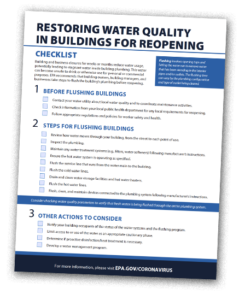As the state of Iowa looks at reopening businesses after an extended COVID-19 shutdown, there are a number of preparation steps to be taken to ensure the safety of employees and customers. One thing that may not be top of mind for many people is the condition of the building’s water system.
Prolonged shutdown or reduced operation such as those experienced during this pandemic may impact the water quality in commercial businesses, including schools, daycares, and beauty salons, just to name a few. Along with potential microbial hazards, the stagnant water may have produced disinfectant by-products, metals leaching into the stagnant water, and even a possible build-up of sewer gases.
Here are a few suggestions from Osceola Water Works to help you keep your staff and clientele safe as you transition back into business:
- Flush the entire building, through all points of use like showers, sink faucets, water fountains, and toilets. This will clear out all the low quality water in the system and replace it with clean, high quality water from the water mains under the street.
- Start in the basement and work upward to other floors, flushing one area and fixture at a time.
- Flush cold-water lines first. Make sure the water heater is set to at least 120°F and run the hot water through all taps until it reaches its highest temperature.
- Flush out ice machines, dishwashers, and any other appliances that use water. Some appliances may need additional cleaning besides flushing, such as discarding any ice made prior to flushing.
- Inspect all water system equipment for issues that may affect function. Include cooling towers, boilers, pumps, and backflow preventers. Verify that no annual inspections or test cycles were missed during the closure.
- Clean fountains and all decorative water features, being sure to remove all visible debris, slime, and biofilm.
These are basic, preliminary steps to try to get your business’s water quality back to where it was before the prolonged shutdown. There are more comprehensive instructions for building reopening on the CDC Website as well as from the Environmental Science Policy & Research Institute (ESPRI). And for a comprehensive checklist from the Environmental Protection Agency (EPA), you can click on the image to the side to open, view and print their PDF.

